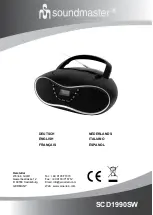
XONE:32
User Guide
15
The TRANSMUTE Buttons
The unique Allen & Heath TRANSMUTE function
combines the popular TRANSFORM and PUNCH
effects into one ‘intelligent’ quick action performance
button per side of crossfader.
What it does is determined by the position of the
crossfader. With the fader at any position away from
the opposite side to the button it provides the
TRANSFORM function, muting (turning off) the music.
With the fader fully at the opposite side it becomes a
PUNCH button switching in the music to layer it on
top of the other channel which is playing. This gives
you both effects at the same time.
Using the VCF
A Voltage Controlled Filter is an audio filter whose cut-off frequency is altered by a DC control voltage rather
than a variable resistor. This produces a much wider operating range and more control over the filter response
to create unlimited combinations of tonal effect. The
XONE:32
filter is ‘state variable’. This means that it
provides three simultaneous filter types, high-pass, band-pass and low-pass. The analogue circuit with its
resonant feedback path produces the classic warm filter sound often associated with analogue synthesisers.
Each channel can be switched in or out of the filter path using its
FILTER
switch. Use this to punch the filter
effect in or out. The blue LED lights when the channel is routed through the filter.
Adjust the
RESONANCE
control to change the ‘Q’ or
‘sharpness’ of the filters. This affects how they respond around
the cut-off frequency. At the minimum MILD setting the filters
have a gentle roll-off ‘knee’ giving a subtle, smooth response.
At the clockwise WILD setting they produce a resonant
feedback boost around cut-off resulting in some very dramatic
performance effects. The sound varies according to the filter
type selected. To avoid unexpected results it is best to start
experimenting with RESONANCE set to a low (mild) position.
High RESONANCE settings can result in significant boost of selected frequencies. Reduce the
channel level if the signal levels increase enough to light the red PK LEDs in the output meters. Failure
to do this may result in system overload and distortion.
The
VCF FREQUENCY
can be adjusted in two ways, either manually using the VCF slider control, or
automatically by modulating it with the LFO. This parameter is controlled during performance to create the
dramatic effects possible only with a filter of this type.
VCF slider frequency sweep
When the LFO is switched off the VCF slider becomes a manual
control of the cut-off frequency. It sweeps the frequency from a
very low 100Hz to ultra high 20kHz. The slider provides a light,
smooth action and is used in a similar way to the crossfader to
creatively enhance the musical performance. The effect
depends on the filter type selected.
LFO frequency modulation
When the LFO is switched on it takes control of the VCF cut-off frequency. The
LFO ON
switch LED lights red
when it is on. The VCF slider is no longer a manual sweep control but instead becomes the depth control to
determine how much the LFO affects the filter. It ranges from no effect at the fully right position to maximum
effect when fully left. The frequency is modulated by the LFO at the speed set using the
TAP TEMPO
button.
Simply tap the button at the tempo you want and the LFO will follow and lock on to this speed. The speed is
always shown by the LFO ON LED flashing green, even when it is switched off. Pressing the
x2
switch doubles
the speed dramatically changing the way the filter affects the music with the beat.
We recommend that you experiment with the filter controls to fully explore the possibilities before you use the
effects live. Combined with the
DRS™
user presets you have a powerful tool for complex yet instant
performance creativity.
LO
0dB
RESONANCE
LO (MILD)
HI (WILD)
MID
FREQUENCY
HI
Содержание Xone:32
Страница 1: ...USER GUIDE Publication AP4264 P R O F E S S I O N A L D J M I X E R ...
Страница 24: ......
Страница 25: ...Check out my Internet site http www xone co uk ...











































